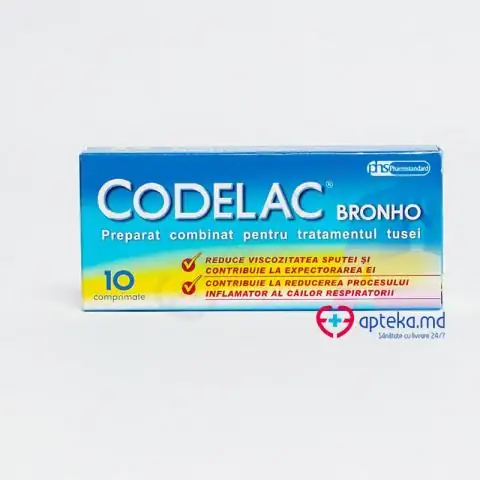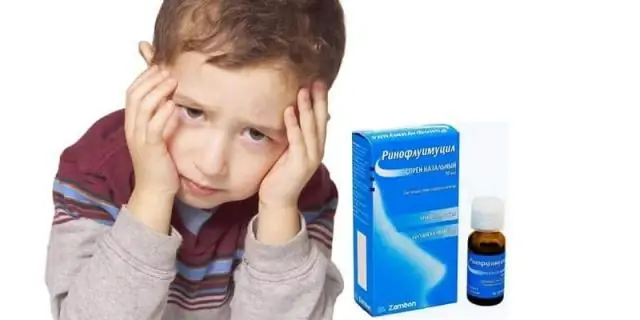Bronhosan
Bronhosan: instructions for use and reviews
- 1. Release form and composition
- 2. Pharmacological properties
- 3. Indications for use
- 4. Contraindications
- 5. Method of application and dosage
- 6. Side effects
- 7. Overdose
- 8. Special instructions
- 9. Drug interactions
- 10. Analogs
- 11. Terms and conditions of storage
- 12. Terms of dispensing from pharmacies
- 13. Reviews
- 14. Price in pharmacies
Latin name: Bronchosan
ATX code: R05CA10
Active ingredient: bromhexin (bromhexinum)
Manufacturer: Zentiva as, Slovak Republic
Description and photo update: 2018-08-07

Bronhosan is a drug with bronchodilator, mucolytic and expectorant effects.
Release form and composition
The drug is available in the form of drops for oral administration (in 25 ml vials with a dropper cap).
1 g of drops of Bronhosan contains:
- Bromhexine hydrochloride - 8 mg;
- Levomenthol - 1.5 mg;
- Fennel oil - 750 mcg;
- Eucalyptus oil - 250 mcg;
- Oregano oil - 250 mcg;
- Anise oil - 250 mcg;
- Peppermint Oil 250 mcg
Auxiliary components of the drug:
- Sodium hydrogen phosphate;
- Sucrose;
- Polysorbate 80;
- Potassium dihydrogen phosphate;
- Ethanol 96%;
- Hydrochloric acid 35%;
- Triethylene glycol;
- Purified water.
Pharmacological properties
Bromhexine reduces the viscosity of bronchial secretions by stimulating the epithelial cells that produce it. The substance helps to activate the ciliated epithelium, which facilitates the passage of sputum. It is assumed that bromhexine induces the synthesis of a surfactant, which ensures the stability of alveolar respiration, and also has a mild antitussive effect.
Menthol is characterized by mucolytic, vasodilating, expectorant and spasmolytic effects. Peppermint oil has an antispasmodic effect, and fennel oil, in addition to the above, has additional antimicrobial and expectorant effects. Anise oil normalizes the function of the ciliated epithelium, providing anti-inflammatory and secretolytic effects. Eucalyptus oil has expectorant, antimicrobial and bactericidal effects, more pronounced when using the drug in the form of inhalation. Oregano oil activates the function of the bronchial glands, it also has a sedative and antimicrobial effect.
Pharmacodynamics
Due to the multicomponent nature of Bronhosan, its pharmacodynamics have not been sufficiently studied.
Pharmacokinetics
When taken orally, bromhexine is almost completely (not less than 99%) absorbed in the digestive tract within 30 minutes. Its maximum plasma level is recorded approximately 1 hour after ingestion. Approximately 80% of bromhexine is extensively metabolized due to the "primary passage" effect through the liver. In blood plasma, the substance binds well to proteins, penetrates the placental and blood-brain barriers.
In the liver, bromhexine is demethylated and oxidized to form ambroxol, a pharmacologically active metabolite. The half-life of the substance is approximately 15 hours due to the low rate of reverse diffusion from tissues. Bromhexine is excreted mainly through the kidneys, and in patients with chronic renal failure, the excretion of its metabolites is impaired. With repeated administration, accumulation of bromhexine is observed.
Indications for use
According to the instructions, Bronhosan is intended for the treatment of diseases of the respiratory tract, which are accompanied by the formation of difficult-to-separate bronchial secretions:
- Obstructive bronchitis;
- Bronchial asthma;
- Tracheobronchitis;
- Bronchiectasis;
- Pneumoconiosis;
- Emphysema of the lungs;
- Cystic fibrosis.
The drug can be prescribed after surgical and diagnostic interventions in the respiratory tract.
Contraindications
Contraindications to the use of Bronhosan are:
- Ulcerative diseases of the stomach and duodenum (in the acute phase of the course);
- Gastric bleeding;
- Hypersensitivity to drug components;
- I trimester of pregnancy and lactation.
The drug is prescribed with caution to patients suffering from:
- Alcoholism;
- Chronic renal failure;
- Liver disease;
- Epilepsy.
Instructions for the use of Bronhosan: method and dosage
When taken internally
Bronhosan drops should be taken before or after meals. The drug must be diluted with water, or applied to a sugar cube with a sufficient amount of liquid. It is recommended to take the drug 4 times per knock:
- Adults and children over 6 years old - 20 drops each;
- Children from 2 to 6 years old - 10 drops each;
- Children under 2 years old - 5 drops each.
The duration of therapy is determined by the clinical manifestations of the disease.
If the patient has severe renal dysfunction, it is recommended to reduce the dose or increase the interval between doses of the drug.
When applied by inhalation
Bronchosan must be diluted with distilled water in a 1: 1 ratio and heated to body temperature. Doses of the drug for 1 inhalation:
- Adults - 4 ml;
- Children over 10 years old - 2 ml;
- Children from 6 to 10 years old - 1 ml;
- Children from 2 to 6 years old - 10 drops;
- Children under 2 years old - 5 drops.
Inhalation must be carried out 2 times a day.
1 ml of Bronhosan contains 25 drops.
Side effects
Most patients tolerate the drug well, but the following side effects are possible:
- Dyspeptic disorders;
- Exacerbation of gastric and duodenal ulcers;
- Increased activity of hepatic transaminases in the blood serum (reversible);
- Allergic reactions in the form of edema of the skin and mucous membranes, erythema.
Overdose
In case of an overdose of Bronhosan, the side effects typical for it may increase. In this case, it is recommended to urgently perform gastric lavage followed by oral administration of activated charcoal. If necessary, symptomatic therapy is prescribed.
special instructions
Drinking plenty of fluids enhances the mucolytic effect of Bronhosan.
Influence on the ability to drive vehicles and complex mechanisms
Since ethanol is part of Bronhosan, during treatment it is recommended to refrain from driving vehicles and performing other potentially hazardous types of work that require increased concentration and immediate psychomotor reactions.
Drug interactions
Bromhexine increases the degree of penetration into the bronchial secretion of sulfa drugs and some antibiotics (oxytetracycline, amoxicillin, cephalexin, erythromycin) in the first 4-5 days after the start of antibiotic therapy.
It is not recommended to combine Bronhosan with drugs that contain codeine and other antitussive drugs, since the suppression of the cough reflex makes it difficult to remove liquefied sputum.
When Bronhosan is taken together with non-steroidal anti-inflammatory drugs (oxybutazone, phenylbutazone, salicylates), the irritating effect on the gastric mucosa may increase. The drug is completely incompatible with alkaline solutions.
Analogs
There are no structural analogues of Bronhosan. It is recommended to consult a doctor for prescribing a drug with a similar therapeutic effect.
Terms and conditions of storage
The shelf life is 3 years. Store in a dark, dry place out of reach of children at a temperature of 15-25 ° C.
Terms of dispensing from pharmacies
Available without a prescription.
Reviews about Bronhosan
According to reviews, Bronhosan is effective for wet coughs with difficult sputum discharge. It has a good mucolytic and expectorant effect due to the combination of the main active ingredient bromhexine and the active components of plants, which promote sputum discharge and have anti-inflammatory activity. Many parents note the convenience of using a liquid dosage form (compared to tablets, Bronhosan is more convenient to give to a child). They also use the drug for inhalation. There are reports that in the process of treatment, the cough weakens within 3 days after the start of the intake, but not everyone likes the sharp and burning taste and smell of the medicine.
The price of Bronhosan in pharmacies
The price of Bronhosan in pharmacy chains varies from 224 to 275 rubles (for a 25 ml bottle).

Anna Kozlova Medical journalist About the author
Education: Rostov State Medical University, specialty "General Medicine".
Information about the drug is generalized, provided for informational purposes only and does not replace the official instructions. Self-medication is hazardous to health!







